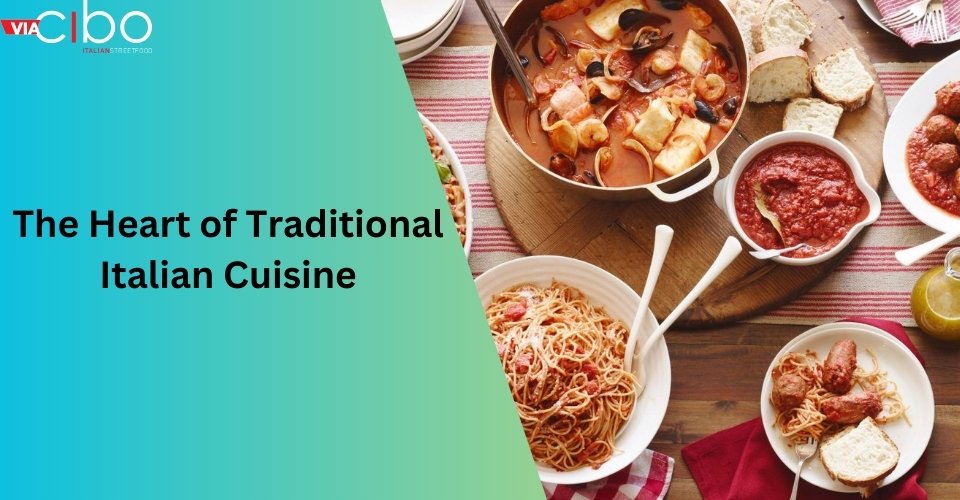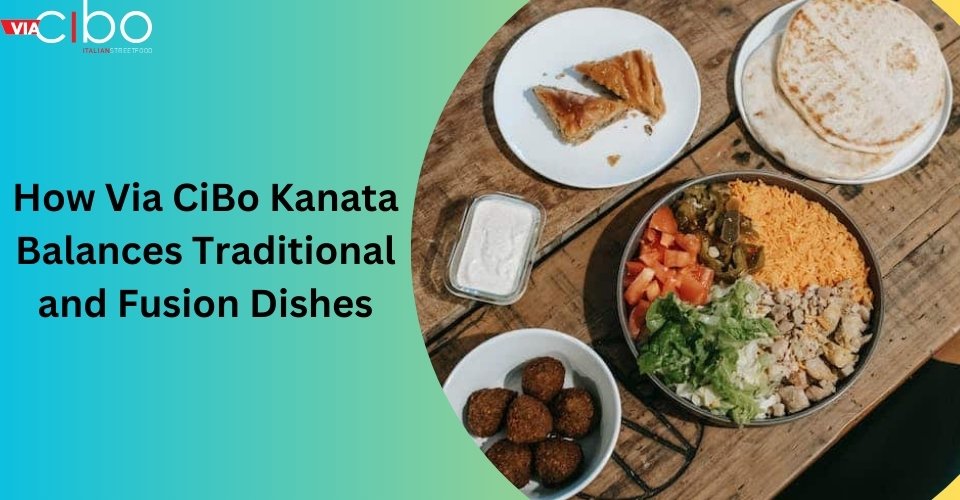
Italian cuisine is renowned worldwide for its rich flavors, timeless recipes, and diverse regional influences. From the coastal regions offering fresh seafood to the heart of Italy’s countryside providing hearty, rustic fare, the versatility of Italian food has made it a global favorite. Traditional Dishes vs Fusion Dishes in Kanata by Via CiBo Kanata 2024.
In Kanata, a growing suburb of Ottawa, this classic culinary tradition is being reinterpreted and reimagined by Via CiBo Kanata, a restaurant that has found the perfect balance between traditional Italian dishes and creative fusion interpretations.
As dining trends evolve, Via CiBo Kanata stands as a prime example of how Italian cuisine can stay true to its roots while adapting to contemporary pilates.
In this article, we explore how Italian food has evolved in Kanata, focusing on the distinct contrasts between traditional and fusion dishes, and how Via CiBo Kanata blends these two culinary worlds into a remarkable dining experience.
The Heart of Traditional Italian Cuisine

Italian food is steeped in tradition, with each region of the country offering its own distinct flavors, techniques, and ingredients. The core of traditional Italian cuisine revolves around high-quality, fresh ingredients and simple cooking methods that allow the flavors to shine. A few key components define this time-honored style:
Simplicity and Fresh Ingredients
Traditional Italian dishes are built on the principle of simplicity. For instance, a classic plate of Spaghetti Aglio e Olio, consisting of just pasta, olive oil, garlic, and chili flakes, showcases how minimal ingredients can create a complex and satisfying flavor profile. Similarly, dishes like Margherita pizza with its fresh mozzarella, basil, and tomatoes, emphasize quality ingredients, highlighting the Italian principle of “less is more.”
Regional Influences
Each region of Italy has its own culinary identity, shaped by the geography, climate, and historical influences. For example:
- Sicilian cuisine features seafood, citrus fruits, and almonds, making use of the island’s coastal position.
- Piedmont is famous for its rich sauces and meats, especially truffles and Barolo wine.
- Tuscany offers simple, hearty dishes such as ribollita (a thick vegetable soup) and bistecca alla fiorentina (Florentine steak).
This regionality is a cornerstone of traditional Italian cooking, with many Italian restaurants, including Via CiBo Kanata, focusing on authentic recipes passed down through generations.
Traditional Dishes at Via CiBo Kanata
At Via CiBo Kanata, traditional Italian offerings remain a central part of the menu. Guests can enjoy handmade pasta, such as Pappardelle al Ragù, where the rich meat sauce is slow-cooked to perfection, or classic Risotto alla Milanese, prepared with saffron and rich broth. These dishes not only adhere to authentic Italian techniques but also showcase the vibrant flavors that make traditional Italian food so beloved.
The Rise of Fusion Italian Cuisine
While traditional Italian dishes maintain a special place in the culinary world, the evolution of food culture has introduced new techniques, global flavors, and experimental ideas. Fusion cuisine—blending elements from different culinary traditions—has risen in popularity, and Italian cuisine is no exception.
Fusion dishes take the foundational principles of Italian cooking and reimagine them, often incorporating ingredients and cooking styles from other cuisines. The appeal of fusion Italian cuisine lies in its creativity and ability to cater to modern tastes while still honoring Italian traditions.
Global Influences on Italian Cuisine
The globalization of food culture has brought new ingredients and techniques to the Italian kitchen. From Asian spices to Latin American influences, chefs have found ways to blend these global elements with Italian classics. For example, Italian-Asian fusion might include a pizza topped with wasabi, teriyaki chicken, or an Italian-style sushi roll.
In Kanata, Via CiBo Kanata has been at the forefront of this culinary shift, offering unique fusion dishes that combine the best of Italian tradition with exciting global flavors.
Fusion Dishes at Via CiBo Kanata
Via CiBo Kanata’s fusion menu represents a bold interpretation of Italian cuisine. The restaurant has crafted innovative dishes like Truffle Fries with Parmesan and Sriracha Aioli, which combines the familiar comfort of Italian truffle oil fries with the fiery punch of Sriracha. Similarly, their Taco Pizza merges the traditional Italian pizza crust with taco toppings like ground beef, jalapeños, and a drizzle of sour cream and guacamole.
Other fusion dishes include the Italian Sushi Roll, where fresh seafood and avocado are paired with Italian olive oil and balsamic vinegar, creating a cross-cultural culinary experience. These dishes offer diners an opportunity to experience the comfort of familiar Italian flavors while exploring new and unexpected combinations.
How Via CiBo Kanata Balances Traditional and Fusion Dishes

What sets Via CiBo Kanata apart is its ability to strike a balance between traditional Italian fare and contemporary fusion creations. The restaurant maintains an unwavering commitment to quality ingredients and time-honored cooking techniques, while also embracing innovation and creativity. This fusion approach allows diners to appreciate the rich flavors of Italy while savoring the excitement of new culinary frontiers.
A Deep Respect for Tradition
At the heart of Via CiBo Kanata’s fusion dishes is a deep respect for the authenticity of Italian cuisine. While they experiment with bold flavors and unusual combinations, the essence of the dishes remains grounded in Italian culinary tradition. For instance, their Neapolitan-style pizza, known for its thin crust and fresh toppings, is prepared with the same care and dedication as it would be in Naples, yet it can also serve as a canvas for fusion toppings like Thai chili sauce or smoked salmon.
Innovation Without Compromise
Fusion dishes are often created with the intent to surprise and delight, and Via CiBo Kanata has perfected this balance. The chefs at Via CiBo Kanata don’t just throw ingredients together; each dish is carefully crafted to enhance the flavors of both cuisines. The fusion process is not about sacrificing quality for creativity but about expanding the boundaries of what Italian cuisine can be, all while respecting its origins.
The Growing Popularity of Fusion in Kanata
Kanata’s culinary scene has evolved significantly over the past decade, with residents seeking out new dining experiences that blend tradition with modernity. As a growing suburb of Ottawa, Kanata attracts a diverse group of food enthusiasts, many of whom have traveled the world or experienced a wide range of global cuisines. The demand for fusion dishes reflects this openness to new ideas and flavors.
Restaurants like Via CiBo Kanata have capitalized on this shift in dining preferences by offering fusion dishes that cater to adventurous eaters without sacrificing the authentic, comforting elements that Italian cuisine is known for. The restaurant has managed to carve out a unique niche where traditional and fusion meet, appealing to both purists and those eager to try something new.
Conclusion: The Future of Italian Cuisine in Kanata
The evolution of Italian cuisine in Kanata, as seen through the lens of Via CiBo Kanata, reflects a broader trend in global dining. Traditional dishes continue to be loved and cherished, but the incorporation of fusion elements breathes new life into Italian cooking. Via CiBo Kanata has successfully merged the past and the present, offering a dining experience that honors the flavors of Italy while embracing the creativity and experimentation of modern culinary trends.
For those in Kanata looking to explore the intersection of tradition and innovation, Via CiBo Kanata offers a compelling journey through the rich tapestry of Italian cuisine. Whether you’re enjoying a classic Carbonara or indulging in a bold Fusion Pizza, Via CiBo Kanata proves that Italian food, at its best, is not just about preserving tradition, but about pushing the boundaries of what Italian cuisine can be in an ever-changing culinary world.


